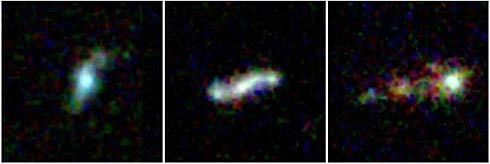Detecting small galaxies similar to the early Milky Way
Astronomers have discovered that galaxies can be born in the same time as the Earth's precursor to the Milky Way.
These galaxies are about 1/10 to 1/20 the size of the Milky Way and have 40 times fewer stars. Light emitted about 2 billion years after the Big Bang, the theoretical explosion that produced the universe 13.7 billion years ago. Therefore, small galaxies are considered to exist in a fledgling universe.
The galaxies are not the most distant objects ever discovered through the Hubble Telescope, but astronomers see this as a precursor to larger spiral structures like the Milky Way.
Eric Gawiser, an astronomer at the Rutgers School of Arts and Sciences, said: 'Finding and discovering them as a step in the evolution of the galaxy is similar to finding an important fossil. human evolution. '
Gawiser and Caryl Gronwall - astrophysicist at the University of Pennsylvania, published their findings at an annual meeting of the American Astronomical Society (AAS) in Austin, Texas.
Gronwall commented on the spiral galaxies made up mostly of hot stars, emitting a special type of ultraviolet light called ' Lyman alpha '. "They have a lot of different shapes - round, elongated or slightly flattened and we are working to accurately measure their size. '

Three galaxies are about 12 billion light-years away from Earth, the image recorded by the Hubble telescope.Astronomers believe that these asteroids form similarly to galaxies that formed billions of years ago.(Photo: NASA)
Computerized data and simulations of how the galaxies collided, led Gronwal and Gawiser to conclude: galaxies with strong Lyman alpha rays are precursors to spiral galaxies. Gawiser said: 'Cosmological theory holds that spiral galaxies evolve from galaxies like this. The difficulty here is finding them. We have observed other early galaxies, but they are larger and evolve into elliptical galaxies, not spirals. '
Nigel Sharp, project leader at the National Science Foundation, Astrophysics, Gronwal and Gawiser statements using Hubble glasses and other observatories to draw this important discovery.'The team has come very close to the ability to find galaxies similar to our Milky Way when they were born.'

Hubble telescope taken from Earth with space shuttle in March 2002. (Photo: Reuters / NASA / Handout)
- The Milky Way has no numerical date
- The first image of the early Milky Way Strip
- The Milky Way is lighter than we thought
- Detecting the minimum mass of the galaxy
- What is the Milky Way? What are the different galaxies and galaxies?
- Detecting weird ghosts only contains 0.01% stars
- Nearly 900 galaxies hidden behind the Milky Way
- Things you don't know about galaxies
- The true size of the Milky Way
- The 'monster' called the Fairy is about to swallow the galaxy containing the Earth
- Announced the most accurate volume of the whole Milky Way
- Close up of galactic conflict
 Van Allen's belt and evidence that the Apollo 11 mission to the Moon was myth
Van Allen's belt and evidence that the Apollo 11 mission to the Moon was myth The levels of civilization in the universe (Kardashev scale)
The levels of civilization in the universe (Kardashev scale) Today Mars, the sun and the Earth are aligned
Today Mars, the sun and the Earth are aligned The Amazon owner announced a secret plan to build a space base for thousands of people
The Amazon owner announced a secret plan to build a space base for thousands of people